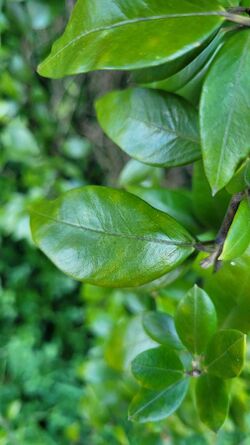Biology:Stigmella kaimanua
| Stigmella kaimanua | |
|---|---|

| |
| Male holotype | |
| Scientific classification | |
| Domain: | Eukaryota |
| Kingdom: | Animalia |
| Phylum: | Arthropoda |
| Class: | Insecta |
| Order: | Lepidoptera |
| Family: | Nepticulidae |
| Genus: | Stigmella |
| Species: | S. kaimanua
|
| Binomial name | |
| Stigmella kaimanua Donner & Wilkinson, 1989[1]
| |
Stigmella kaimanua is a moth of the family Nepticulidae.[2] This species is endemic to New Zealand and has been observed in the southern parts of the South Island. S. kaimanua inhabits lowland and lower montane forest. The larvae mine the leaves of Parsonsia heterophylla. The mine is linear and continues down the stems for a short distance. Larvae have been observed April to August. The cocoon is probably attached to the leaf litter on the ground under the host plant. There is one generation per year. Adults are on the wing in November and December and are attracted to light.
Taxonomy
This species was first described in 1989 by Hans Donner and Christopher Wilkinson from specimens collected in Fiordland, Otago and Southland.[3] The male holotype specimen, collected at Woodhaugh, Dunedin on 5 November 1982 by B.H. Patrick, is held in the New Zealand Arthropod Collection.[3]
Description
The larvae of S. kaimanua are 3–4 mm long and whitish yellow.[3]
Donner and Wilkinson described the male of this species as follows:
Head. Frontal tuft pale brown; scape white; collar grey; antenna brown-grey, with about 30 segments. Thorax brown. Forewing about 3 millimetres (0.12 in). long, grey-brown in various shades, with 3 black spots - antemedial, medial, and apical; a blackish-brown area basally, near costa; fringe grey. Hindwing silvery grey; cilia concolorous. Abdomen brown-grey.[3]
The female of the species is similar appearance to the male but has larger and darker forewings and antenna with 24 segments.[3]
Distribution
This species is endemic to New Zealand.[1][4] S. kaimanua has been observed in the mid to southern parts of the South Island.[3][5]
Behaviour
Larvae mine the leaves of their host plant. The mine is linear and situated in either the upper or lower mesophyll layer of the leaf tissue, often near the midrib. The gallery continues down the stem for a short distance. Larvae have been recorded from April to August. The cocoon is probably attached to leaf litter on the ground under their host plant. Adults have been recorded in November and December. There is one generation per year.[3] Adults are attracted to light.[5]
Habitat and hosts
S. kaimanua inhabits lowland and lower montane forest.[3] The larvae feed on Parsonsia heterophylla.[6][7]
References
- ↑ 1.0 1.1 "Stigmella kaimanua Donner & Wilkinson, 1989". https://biotanz.landcareresearch.co.nz/scientific-names/f4b2cedb-ea82-45d5-b948-7ac0333e4c6a.
- ↑ , Wikidata Q28109648
- ↑ 3.0 3.1 3.2 3.3 3.4 3.5 3.6 3.7 , pp. 26-27, Wikidata Q45079930
- ↑ , pp. 461, Wikidata Q45922947
- ↑ 5.0 5.1 Christchurch City Council (2 September 2015). "District Plan Review Subcommittee Meeting 2 September 2015 Attachments". https://christchurch.infocouncil.biz/Open/2015/09/DPSC_02092015_ATT.PDF.
- ↑ "Stigmella kaimanua Donner & Wilkinson, 1989". 2011. https://plant-synz.landcareresearch.co.nz/ReportForm.aspx?RecordId=62&Type=H&ReportType=Adv&SortBy=Alpha&Biostatus=a,c,e,n.
- ↑ Pendergrast, Aja (2019-04-28). "New Zealand jasmine: a real endemic climber | Auckland Zoo News" (in en). https://www.aucklandzoo.co.nz/news/new-zealand-jasmine-a-real-endemic-climber.
Wikidata ☰ Q7616692 entry
 |


